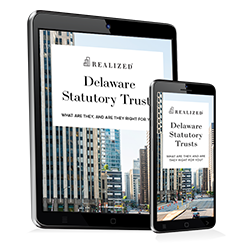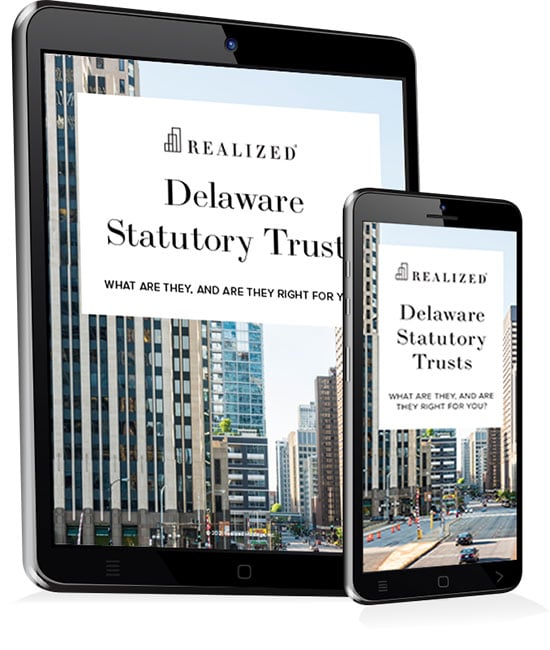
Participating in a Delaware Statutory Trust (DST) offers several potential benefits to investors, such as passive income and access to institutional-grade real estate assets. When structured through a 1031 exchange, DSTs may also provide tax-deferral opportunities. However, as with any investment, DSTs are subject to various risks—including interest rate risk.
Because interest rates fluctuate and are influenced by macroeconomic factors, they can significantly affect multiple aspects of a DST, including the net operating income of the underlying properties and, by extension, the distributions paid to investors. Let’s take a closer look at how interest rate risk may impact DSTs and discuss considerations for managing its effects.
What Is Interest Rate Risk?
In the broader world of investing, interest rate risk is the potential for investment losses following increased interest rates. This type of risk is well-known in fixed-income instruments such as bonds. Bond prices typically fall when interest rates climb. Delaware Statutory Trust interest rates are a bit different but carry the same principle.
The key distinction stems from the structure of the DST itself. The DST owns an underlying income-generating property. The income is then distributed as dividends to the investors who own fractional interests in the DST. However, the sponsor may still borrow funds to access the property. This creates debt, which can be affected by interest rates. Falling rates may improve property valuations and potentially increase net income. Conversely, increasing rates may diminish the profitability of the asset. Understanding this dynamic is key to navigating DST performance.
The Impact of Interest Risk in DST Investments
Fluctuating financial rates create a ripple effect on DSTs. Here are some of the most impactful challenges you may encounter.
Cap Rates and Property Valuations
When interest rates rise, capitalization (cap) rates also tend to increase. Because property values are inversely related to cap rates, this rise may result in lower property valuations within the DST. This affects not only the potential resale value at the end of the holding period but also investor equity.
Distribution Yield
The income generated by the DST’s underlying property comes mostly from rental activity. Rising interest rates can put financial pressure on tenants, potentially leading to missed rental payments or renegotiated lease terms at lower rates. The added economic stress may also increase tenant turnover. As you lose tenants, finding new ones to lower the vacancy rate may also become challenging as demand for commercial real estate falls. These dynamics can ultimately reduce net operating income and lower investor distributions. Lack of Access to More Favorable Financing
Under IRS Revenue Ruling 2004-86, DSTs are required to utilize pre-set, fixed-rate, non-recourse financing, and they are not permitted to refinance or renegotiate debt once established. While this structure insulates the DST from rising interest expenses during the holding period, it also means the trust cannot benefit from lower interest rates that arise afterward. This may reduce the DST's competitiveness relative to newer offerings that secure more favorable terms.
Strategies for Managing DST Interest Rates
Because investors in a Delaware Statutory Trust (DST) typically have no control over management decisions after the offering period, it's critical to evaluate interest rate exposure before selecting a DST. Here are several strategies to consider when managing this form of risk:
1. Choose DSTs with Conservative Leverage
DSTs with lower loan-to-value (LTV) ratios are generally less sensitive to rising interest rates. A lower LTV means there’s more equity relative to debt, which can reduce pressure on cash flows and mitigate the impact of declining property valuations during economic tightening.
2. Double Check Debt Structures
DSTs designed for 1031 exchange eligibility must utilize fixed-rate, non-recourse debt, per IRS Revenue Ruling 2004-86. This structure offers predictable debt service and aligns with investor expectations for stability. Even so, there are DSTs that have variable debt structures. Those who find this structure too risky based on projected income rate fluctuations must make sure that they’re entering a DST with fixed-rate debt payments.
3. Diversify Your DST Holdings
DSTs often have relatively low minimum investment thresholds—typically around $100,000—making it feasible for investors to allocate proceeds across multiple properties or asset types. Diversifying across markets or sectors (e.g., essential retail, medical offices) may reduce overall portfolio volatility during periods of rising interest rates. For example, DSTs with healthcare or essential retail properties may remain more resilient during periods of economic uncertainty.
4. Work With Experienced Sponsors
Due to the passive nature of DST investments, sponsor quality is critical. Sponsors with a strong track record in tenant relations and asset management may be better positioned to preserve occupancy and stabilize income in a challenging rate environment. Review sponsor disclosures, historical performance, and property-level business plans as part of your due diligence.
What Happens If You Ignore DST Interest Rate Risk?
Overlooking interest rate trends in DST investing can expose you to long-term performance risks.. For example, entering a DST during a low-interest-rate environment without analyzing the broader rate outlook may result in reduced relative returns if more favorable opportunities arise later. Although DSTs are not actively managed post-acquisition, changes in interest rates can influence property values, income stability, and market competitiveness. Investors who overlook these factors may find their investment underperforming relative to shifting market conditions.
Wrapping Up: Delaware Statutory Trust Interest Rate Risk
While Delaware Statutory Trusts offer potential tax and income benefits, they also come with structural limitations that can amplify certain risks—especially interest rate risk. As such, before entering a DST, taking steps like LTV analysis, tenant mix, sector exposure, and diversification can help mitigate these indirect effects.
The tax and estate planning information offered by the advisor is general in nature. It is provided for informational purposes only and should not be construed as legal or tax advice. Always consult an attorney or tax professional regarding your specific legal or tax situation.
Article written by: Story Amplify. Story Amplify is a marketing agency that offers services such as copywriting across industries, including financial services, real estate investment services, and miscellaneous small businesses.
https://www.irs.gov/pub/irs-drop/rr-04-86.pdf



